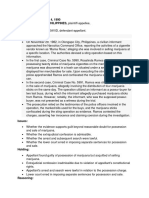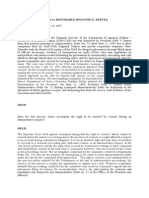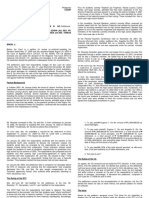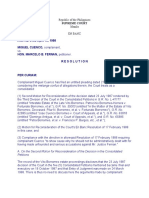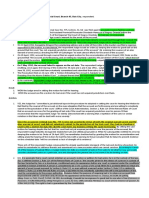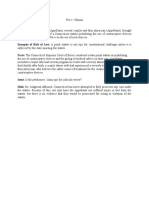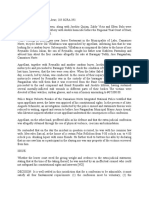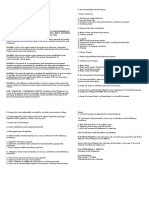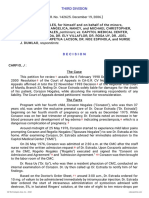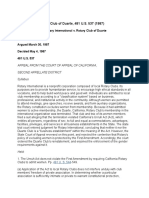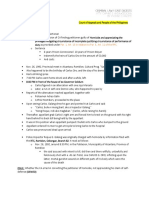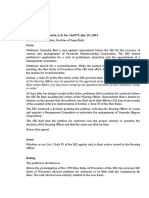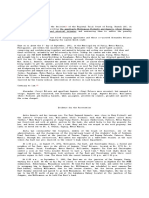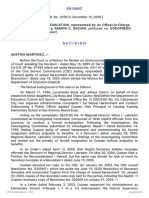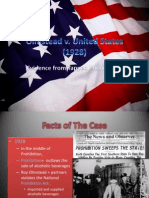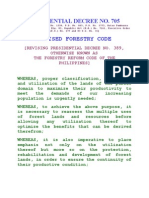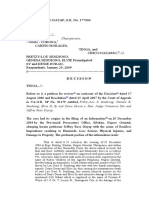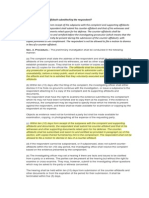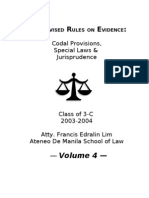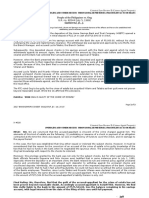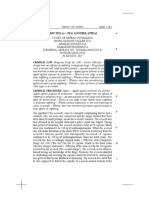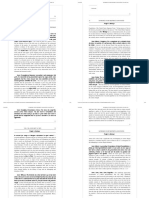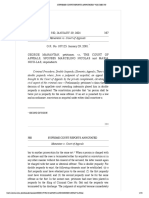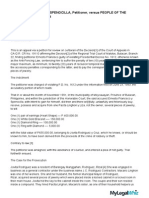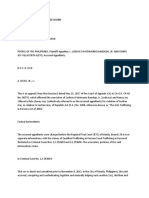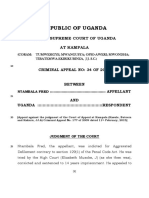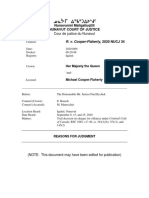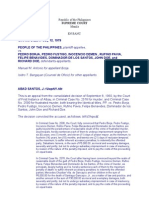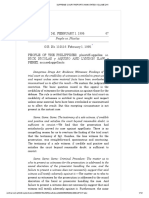PPL v. Samus
PPL v. Samus
Uploaded by
clandestine2684Copyright:
Available Formats
PPL v. Samus
PPL v. Samus
Uploaded by
clandestine2684Original Description:
Original Title
Copyright
Available Formats
Share this document
Did you find this document useful?
Is this content inappropriate?
Copyright:
Available Formats
PPL v. Samus
PPL v. Samus
Uploaded by
clandestine2684Copyright:
Available Formats
PEOPLE OF THE PHILIPPINES, appellee, vs. SAMUS, appellant. DECISION PANGANIBAN, J.
GUILLERMO
B. With respect to Criminal Case No. 5016-96-C for the killing of John Ardee Balisi, this Court finds the accused guilty beyond reasonable doubt, of the crime of Murder and is hereby sentenced to suffer the penalty of, after appreciating the aggravating circumstance of dwelling, death. The accused is likewise ordered to indemnify the heirs of John Ardee Balisi the amount of FIFTY THOUSAND PESOS (P50,000.00) for his death and another FIFTY THOUSAND PESOS (P50,000.00) as and for moral and actual damages and cost of suit.[2] Two separate Informations,[3] both filed on November 27, 1996, charged appellant as follows: Criminal Case No. 5015-96-C That on or about 2:30 oclock in the afternoon of September 2, 1996 at San Ramon de Canlubang, Brgy. Canlubang, Municipality of Calamba, Province of Laguna, and within the jurisdiction of this Honorable Court, the accused above-named, with intent to kill, treachery, evident premeditation and taking advantage of superior strength, did then and there wilfully, unlawfully and feloniously hold the neck, strangle and thereafter bange[d] the head on the concrete pavement floor of one DEDICACION BALISI Y SORIANO, a 61 years of age, woman, thereby inflicting upon her fractured bones, serious and mortal wounds which directly caused her death, to the damage and prejudice of the surviving heirs of the said Dedicacion Balisi y Soriano. That in the commission of the crime the aggravating circumstances of treachery, evident premeditation and taking advantage of superior strength were in attendant and ordinary aggravating circumstance committing a crime with disregard of respect due the offended party by reason of her age and sex. Criminal Case No. 5016-96-C That on or about 4:30 oclock in the afternoon of September 2, 1996 at San Ramon de Canlubang, Brgy. Canlubang, Municipality of Calamba, Province of Laguna and within the jurisdiction of this Honorable Court, the accused above-named, with intent to kill, treachery, evident premeditation and taking advantage of superior strength, did then and there wilfully, unlawfully and feloniously hold the neck, strangle and thereafter bang[ed] the head on the concrete pavement floor of one JOHN ARDEE BALISI Y SORIANO, a six year old boy, thereby inflicting upon him fractured bones, serious and mortal
While it is true that the confessions of appellant were made without benefit of counsel, they are still admissible in evidence because of appellants failure to make timely objections before the trial court. If only the defense had proffered them on time, the prosecution could have been warned of the need to present additional evidence to support its case. To disregard a major portion of the prosecutions case at a late stage during an appeal goes against the norms of fundamental fairness. Indeed, justice is dispensed not only for the accused, but also for the prosecution. Be that as it may, and even if we now affirm appellants conviction for murder, we do not, however agree with the trial courts imposition of the death sentence, because the proven aggravating circumstance of dwelling was not alleged in the Information. The Case For automatic review by this Court is the Decision [1] dated October 8, 1998, issued by the Regional Trial Court of Calamba, Laguna, Branch 36, in Criminal Case Nos. 5015-96-C and 5016-96-C. The trial court found Guillermo Samus guilty beyond reasonable of two counts of murder. The decretal portion of its Decision reads as follows: WHEREFORE: A. With respect to Criminal Case No. 5015-96-C for the killing of Dedicacion Balisi, the Court finds the accused guilty beyond reasonable doubt of the crime of Homicide and is hereby sentenced to suffer the penalty of, after appreciating the aggravating circumstance of dwelling and after applying the Indeterminate Sentence Law, imprisonment of 10 years and 1 day of Prision Mayor as minimum up to 20 years of Reclusion Temporal as maximum. The accused is hereby ordered to indemnify the heirs of Dedicacion Balisi the amount of FIFTY THOUSAND PESOS (P50,000.00) for her death and another FIFTY THOUSAND PESOS (P50,000.00) as and for moral and actual damages and cost of suit.
[4]
wounds which directly caused his death, to the damage and prejudice of the surviving heirs of the said John Ardee Balisi y Soriano. That in the commission of the crime the aggravating circumstances of treachery, evident premeditation and taking advantage of superior strength were in attendan[ce]. When arraigned on May 28, 1997, appellant, assisted by his counsel de oficio,[5] pleaded not guilty.[6] In due course, he was tried and found guilty. The Facts - Version of the Prosecution The Office of the Solicitor General (OSG) summarized the evidence for the prosecution in this wise:[7] Appellant was a farmer, tilling and living in the land of Miguel Completo at Barangay Niugan, Cabuyao, Laguna. The victims, sixty two (62) year old Dedicacion Balisi and her grandson, six (6) year old John Ardee Balisi, were the neighbors of appellants father at San Ramon de Canlubang, Brgy. Canlubang, Calamba, Laguna. At 4:20 P.M. on September 2, 1996, Senior Police (SP) Inspector Rizaldy H. Garcia was at his office at the 4th PNP Criminal Investigation Group Regional Office at Camp Vicente Lim in Calamba, Laguna when he received an order from his superior to investigate the murder of the two victims. Their office had received a telephone call from a local barangay official informing them of the victims deaths. Arriving at the victims residence at Block 8, Lot 6 at San Ramon, Brgy. Canlubang, Calamba, Garcia and his team conducted an investigation, making a sketch of the relative positions of the victims, lifting fingerprints from the crime scene and taking pictures. Thereafter, an investigation report was prepared by Garcia and signed by his superior, Colonel Pedro Tango. The investigators likewise found a pair of maong pants, a white T-shirt, a handkerchief and dirty slippers in the bathroom and roof of the house. A pair of earrings worn by Dedicacion Balisi was likewise reported missing from her body by her daughter, Nora B. Llore[r]a. The victims bodies were brought to the Funeraria Seerez de Mesa in Calamba where Senior Inspector Joselito A. Rodrigo, a medico-legal officer of the PNP Crime Laboratory, performed an autopsy. His findings showed that John sustained three (3) contusions, one of which
lacerated his liver, caused by a blunt instrument, while Dedicacion suffered four (4) contusions, also caused by a blunt instrument. On that same day, September 2, 1996, Ponciano Pontanos, Jr., then a resident of Barangay Niugan, Cabuyao and an acquaintance of appellant, happened to meet appellant at Sammy Pachecas house in the same barangay where appellant asked Ponciano to accompany him to Poncianos wife to pawn a pair of earrings. Poncianos wife was mad at first but upon Poncianos prodding, gave appellant P300.00 with no interest. The earrings were placed in a jewelry box; thereafter, appellant received another P250.00. At 6:00 P.M. on September 10, 1996, Major Jose Pante of the Criminal Investigation Group received information that appellant was the principal suspect in the killing of the two (2) victims and that he was sighted inside the residence of spouses Rolly and Josie Vallejo at Barangay Macabling, Sta. Rosa, Laguna. He then formed and led a team composed of SPO3 Galivo, Intelligence Commission Officer Casis and SPO3 Mario Bitos. Arriving at the site at past 7:00 P.M., the team, accompanied by local barangay authorities, asked permission from the Vallejo spouses to enter the house, which was granted. Shortly thereafter, they heard loud footsteps on the roof. Rushing outside, they saw appellant crawling on the roof. They ordered him to stop, but he suddenly jumped from the roof and landed hard on the ground, sustaining an injury on his ankle and bruises on his left and right forearm. At that point, the police team closed in on appellant who, while trembling and shaking, admitted the killings upon a query from Rolly Vallejo. Appellant was brought to the Camp Vicente Lim PNP Investigation Office where he was informed of his constitutional rights by SPO3 Alex Malabanan. In the morning of September 11, 1996, appellant, assisted by Atty. Arturo Juliano, gave his statement admitting the killings. SPO3 Malabanan also took the statements of tricycle driver Rafael Baliso, the victims relatives Salvacion and Mona Balisi and witness Mary Arguelles, who saw appellant enter the house of Dedicacion Balisi. On the same day, September 11, 1996, PNP Fingerprint Examiner Reigel Allan Sorra took fingerprint samples from appellant. His prints exactly matched with a set of prints found at the crime scene on September 2, 1998. Later that day, SPO3 Mario Bitos was able to recover the pawned earrings from Ponciano who turned them over to SPO3 Malabanan. (Citations omitted) Version of the Defense
Alleging denial and alibi as defenses, appellant presents his version of the incident as follows:[8] Mrs. Fe Vallejo testified that she knew Guillermo Samus. At about 6:00 p.m. of September 10, 1996, Guillermo Samus was in their house. It was then that CIS operatives together with their Brgy. Captain entered their house, arrested and handcuffed Guillermo Samus. It was not true that accused Guillermo Samus hid himself on the roof of her house. When the accused was arrested by the CIS men, together with the barangay officials, the other persons present were the witness and her 3 children. The police were not armed with a warrant of arrest or search warrant. Accused Guillermo Samus denied the accusations against him. He testified that he was a farmer, working on the land of one Miguel Completo at Brgy. Niugan, Cabuyao. From 6:00 a.m. to 5:00 p.m. of September 2, 1996, he was harvesting palay with Eligio Completo; that he never left the farm. He took his lunch at the hut of Miguel Completo; that he arrived home at 6:00 in the afternoon, took his dinner then went to sleep. He further testified that on September 10, 1996, he was at the house of his friend, Rolly Vallejo at Brgy. Macabling, Sta. Rosa, Laguna, when a group of CIS operatives arrived and arrested him inside the same house. It was not true that he jumped from the roof of the house. The CIS people did not have any warrant for his arrest. His kumpadre Rolly Vallejo was not present at that time. He was brought to Camp Vicente Lim where he was tortured until he lost his consciousness. On the same night, he was brought to a hospital, was given medicine, then brought back to the cell where he was handcuffed at the door of the cell. The CIS got hold of the medical certificate. He was forced by the CIS to admit the killing of the victims and the sale of jewelry by means of torture and threat. He also testified that he was forced to execute a document admitting the killing. He was forced to sign said document. He did not know Atty. Juliano and did not talk to him. The victims were the neighbors of his father in the province. He had been in the house of Dedicacion Balisi. He was known to Dedicacion Balisi and her household; and, that the last time he visited the house of Dedicacion Balisi was on August 30, 1996. He was given food by Dedicacion and he later washed dishes, swept the floor, and put dirt in the trash can. He left at 12:00 p.m. that same date and returned to his house in Brgy. Niugan.
On cross-examination, he testified that from Brgy. Niugan to San Ramon de Canlubang it took less than 15 minutes to travel, and he also mentioned that the media interviewed him 2 days after his arrest. He and his relatives in Laguna did not have the capacity to hire/secure the services of a lawyer. The defense also presented Exhibit B (and submarkings), the transcript of stenographic notes of the testimony of Atty. Juliano, given before the Municipal Trial Court of Calamba, Laguna on December 1, 1997 in connection with [C]riminal [C]ase [N]o. 26099, also against Guillermo Samus for theft (of the earrings). The prosecution admitted the existence of said exhibit and the presentation of the witness who was supposed the identify the same was dispensed with. (Citations omitted) Ruling of the Trial Court The trial court found enough pieces of circumstantial evidence to prove the guilt of appellant beyond reasonable doubt. Rejecting his alibi for being unreliable and uncorroborated, it convicted him of homicide for the death of Dedicacion Balisi; and of murder, with dwelling as aggravating circumstance, for the death of John Ardee Balisi. Hence, this automatic review.[9] Assignment of Errors In his Brief, appellant faults the court a quo with the following alleged errors:[10] I The lower court gravely erred in giving credence to the testimonies of police officers to the effect that the accused tried to escape when he was arrested and that he readily admitted responsibility for the crimes. II The lower court gravely erred in admitting and considering evidence that were obtained in violation of the accuseds constitutional rights. III
The lower court gravely erred in holding that there was sufficient circumstantial evidence to warrant the conviction of the accused. IV The lower court gravely erred when it ruled that the qualifying circumstance of abuse of superior strength attended the killing of John Ardee Balisi. The Courts Ruling The appeal is partly meritorious. First Issue: Arrest of Appellant As a general rule, the evaluation by the trial court of the testimony of the witnesses is accorded great respect, if not finality. In the present case, however, there are cogent reasons to disregard its findings with respect to the arrest of appellant on September 10, 1996. The police officers version of the arrest is incredible. Not only are their allegations uncertain and inconsistent, they are also contrary to human experience. We find it hard to believe that anyone would jump from the roof of a two-story house to escape and, after landing on the ground without any broken bones, make a complete turnaround and just meekly surrender without further ado. Even if this story were true, jumping from a roof is not a crime that would justify the warrantless arrest of appellant. It is undisputed that when the CIS team went to the Vallejo residence on the evening of September 10, 1996, it had no warrant of arrest against appellant. Yet, they arrested him. Under the Rules, [11] peace officers may, without a warrant, arrest a person under any of these circumstances: (a) when, in their presence, the person to be arrested has committed, is actually committing, or is attempting to commit, an offense; (b) when an offense has just been committed, and they have probable cause to believe, based on personal knowledge of facts or circumstances, that the person to be arrested has committed it; and (c) when the person to be arrested is a prisoner who has escaped while being transferred from one confinement to another, or from a penal establishment where he or she is serving final judgment or is temporarily confined while the case is pending. None of these circumstances was present when members of the Criminal Investigation Group (CIG) arrested appellant. He was not a prisoner. The killing of Dedicacion and John Ardee Balisi was not done
in the presence of the arresting officers. Since it took place on September 2, 1996, it could not have been considered as having just been committed. Evidently, they unlawfully arrested appellant on September 10, 1996. When they did so, we cannot ascribe to them the presumption of regularity in the performance of official functions, contrary to the court a quos finding. Considering that the arrest of appellant was unlawful, the apprehending officers uncertainty and reluctance in admitting it becomes understandable. In their Joint Affidavit executed on September 11, 1996, they alleged that he had voluntarily surrendered to them. On the other hand, he had allegedly been merely invited by Chief Inspector Jose Pante, according to SPO3 Alex Malabanan. It was only upon being pressed that the police officers admitted that they had indeed made the arrest.[12] We now proceed to the alleged confession. In their Joint-Affidavit, the arresting officers said that after appellant had initially jumped from a two-story house to escape, they closed in on him and he voluntarily surrendered. At the same place where he did so, they conducted a preliminary interview, during which he readily admitted killing Dedicacion and John Ardee Balisi. But during their testimonies, the police officers denied questioning appellant after arresting him. Instead, they claimed that it was Rolly Vallejo who had conducted the preliminary interview in their presence as follows: Pare totoo ba ang sinasabi nila tungkol sa iyo na ikaw ay pinaghihinalaan nilang pumatay sa mag-lola sa Canlubang[?]; to this question appellant allegedly answered, [T]otoo nga pare, ako nga. No further questions were allegedly asked by the law enforcement officers. Instead, they immediately brought appellant to Camp Vicente Lim for further investigation. SPO3 Mario Bitos, on the other hand, stated in his Affidavit, also dated September 11, 1996, that during the conduct of the preliminary interview, appellant admitted that the victims pair of earrings made of gold was taken by him after the incident and x x x sold to Mr. Jhun Pontanos y Matriano, a resident of Bgy. Niugan, Cabuyao, Laguna, for the amount of five hundred (P500) pesos. During his testimony, however, Bitos denied that they had conducted any investigation.[13] Instead, he claimed that upon their arrival at Camp San Vicente Lim, an interview was conducted by the media in the presence of Major Pante, SPO3 Bitos and SPO3 Malabanan (the investigator).[14] From this interview, the team was able to cull from appellant that he was responsible for the killings, and that he had stolen the earrings of Dedicacion Balisi and sold them to Pontanos
for P500. This information was allegedly verified by Bitos upon the order of Major Pante. Thus, the apprehending officers contend that the constitutional rights of appellant were not violated, since they were not the ones who had investigated and elicited evidentiary matters from him. We are not persuaded. The events narrated by the law enforcers in court are too good to be true. Their Sworn Statements given a day after the arrest contradict their testimonies and raise doubts on their credibility. We find the claims of appellant more believable, supported as they are by Fe Vallejo who testified that he had been arrested inside her house, and that Rolly Vallejo was not around then. Evidence to be believed, must not only proceed from the mouth of a credible witness, but must be credible in itself -- such as [that which] the common experience of mankind can approve as probable under the circumstances. We have no test of the truth of human testimony, except its conformity to our knowledge, observation, and experience. Whatever is repugnant to these belongs to the miraculous and is outside of judicial cognizance.[15] Second Issue: Fruit of the Poisonous Tree Appellant claims that his alleged confession to the media while in police custody cannot be admitted in evidence. He further contends that the pair of earrings, the turnover receipt, as well as the testimonies of Pontaos and Bitos, relative thereto should be excluded for being fruits of the poisonous tree. We clarify. After being illegally arrested, appellant was not informed of his constitutional rights to remain silent and to have competent and independent counsel. Hence, any admission elicited from him by the law enforcers during custodial investigation are normally inadmissible in evidence. In their affidavits, the police officers readily admitted that appellant was subjected to a preliminary interview. Yet, during their examination in open court, they tried to skirt this issue by stating that it was only the media that had questioned appellant, and that they were merely present during the interview. However, an examination of the testimonies of the three law enforcers show the folly of their crude attempts to camouflage inadmissible evidence. SPO4 Arturo Casis testified as follows: FISCAL:
Q: And after that what did you do with the accused Guillermo Samus? WITNESS: A: He went with us voluntarily in Camp.
Q: Camp what? A: Camp Vicente Lim, Canlubang, Laguna.
Q: After arriving at Camp Vicente Lim what happened there? A: We turned over him to our investigator CIS.
Q: To whom in particular? A: SPO3 Alex Malabanan, sir.
Q: What was the purpose for your turning over the accused to Alex Malabanan? A: To ask him question and to investigate him.
Q: Before that when you arrived at the camp, did you see many people at the camp? A: I noticed some reporters were there.
Q: Where were the reporters at that time? A: In our office.
Q: Do you know the reason why these reporters were there at that time? A They used to hang out at our office because they have a press office holding in our office.
Q: Did you notice these press people when you brought Guillermo Samus to the camp? A: Yes, sir.
Q: What did they do when you arrived? A: They keep on asking who is this fellow we have arrested.
Q: Did anyone answer them? A: Its up for the investigator and Maj. Pante.[16] xxx xxx
xxx
Q: And the apprehending team did not ask question regarding the alleged involvement of Guillermo Samus to the kiling? A: At the office, sir.[17]
If you know the reason, can you tell us why Guillermo Samus had to be presented to the media first before you as an investigator assigned to the case actually take his statement? May I request, your Honor that the statement of the witness transpired in the vernacular be quoted (sila na po and naginterview).
On the other hand, SPO3 Bitos declared: Q And you said that in your earlier testimony that Guillermo Samus was immediately brought to Camp Vicente Lim which is your headquarters after his arrest on September 10, 1996, is that correct? A Q Yes, sir. And you said that the purpose of bringing Guillermo Samus to your headquarters on that day after his arrest was for further investigation, is that correct? Yes, sir. The member of the CID once Guillermo Samus was there in your custody at Camp Vicente Lim he was immediately investigated right then and there in the headquarters, is that correct? He was interviewed by the media people upon the arrival of said suspect. We were not able to conduct the investigation because of the media people who was also asking question from him, sir. Who authorized the media people to propound questions to Guillermo Samus when he was at your headquarters in the night of September 10, 1996? I think nobody has given the authority to conduct a preliminary investigation with Guillermo Samus that is why we were bother our investigation because these media people were conducting immediate interview with that suspect, sir.[18] xxx xxx xxx A Q A Q A Q A Q A
Because when we arrived at that time the press people were already there and we can no longer prevent from asking or conducting an investigation or interview because the case is already on public knowledge.
ATTY. MANALO: So, after 8:00 p.m. when Guillermo Samus had already finished giving his statement to the media, do you know where Guillermo Samus was brought?
A Q
WITNESS: Yes, sir. Can you tell us where? Yes, sir. After that Guillermo Samus was brought to our office and Maj. Pante talked to him, sir. And do you know where Guillermo Samus spent the night? Yes, sir. Can you tell us where? In our stockade, sir.[19]
For his part, SPO3 Malabanan gave the following testimony during his cross-examination: Q By the way, what time did Guillermo Samus finish giving the statement to the media people on the night of September 10, 1996? A I cannot recall the exact time as to when he finished but I think it is past 8:00 oclock, sir.
The above testimonies do not tie up. Casis categorically stated that appellant had been turned over to SPO3 Malabanan. Appellant noticed reporters in their office, but he did not answer their questions. SPO3 Bitos alleged that the interview by the media could not have been prevented, because it was an ambush interview. Meanwhile, SPO3 Malabanan claimed that when he arrived at the camp, there were already reporters questioning appellant. Malabanan further narrated that after 8:00 p.m., appellant was brought to the office where Major Pante talked to him. In the absence of testimony from any of the media persons who allegedly interviewed appellant, the uncertainties and vagueness about how they questioned and led him to his confession lead us to believe that they themselves investigated appellant and elicited from him uncounselled admissions. This fact is clearly shown by the
Affidavits they executed on September 11, 1997, as well as by their testimonies on cross-examination. Nonetheless, even if the uncounselled admission per se may be inadmissible, under the present circumstances we cannot rule it out because of appellants failure to make timely objections. Indeed, the admission is inadmissible in evidence under Article III, Section 12(1) and (3) of the Constitution, because it was given under custodial investigation and was made without the assistance of counsel. However, the defense failed to object to its presentation during the trial, with the result that the defense is deemed to have waived objection to its admissibility.[20] Can the testimony of Pontaos and the picture of a pair of earrings together with the turnover receipt, which appellant identified during his testimony, be considered inadmissible as the fruit of the poisonous tree and hence be disregarded at this stage of appeal? Upon examination of the records, we find that during the entire examination in court of Prosecution Witness Pontaos, appellant did not question or object to the admissibility of the formers testimony. Worse, the latters counsel even freely cross-examined the witness without any reservations. Having made no objection before the trial court, appellant cannot raise this question for the first time on appeal.[21] The evidence having been admitted without objection, we are not inclined to reject it. If only appellant had made a timely objection to the admissibility of the said testimony, the prosecution could have been warned of the need to present additional evidence to support its case. To disregard unceremoniously a major portion of its case at this late stage when it can no longer present additional evidence as substitute for that which is now claimed to be inadmissible goes against fundamental fairness. Third Issue: Circumstantial Evidence No one saw who killed Dedicacion and John Ardee Balisi. However, to prove appellants culpability for their deaths, the prosecution presented the following circumstantial evidence: 1. Finger and palm prints matching appellants own were found near bloodstains at the scene of the crime. 2. Dedicacion Balisi owned a pair of earrings that she wore every day. Those earrings were missing from her dead body. Appellant pawned those same earrings to Ponciano Pontaos wife on the afternoon of September 2, 1996.
3. Appellant admitted killing Dedicacion and John Ardee Balisi, whose dead bodies were found inside their residence on the afternoon of September 2, 1996. Circumstantial evidence would be sufficient for conviction, if (a) there is more than one circumstance, (b) the facts from which the inferences have been derived are proven, and (c) the combination of all the circumstances is such that it produces a conviction beyond reasonable doubt. These circumstances must be consistent with one other, and the only rational hypothesis that can be drawn therefrom must be that the accused is guilty. They must create a solid chain of events, coherent and intrinsically believable, that pinpoints the accused -- to the exclusion of others -- as the perpetrator of the crime and thereby sufficiently overcomes the presumption of innocence in his or her favor.[22] In the present case, it is indisputable that someone entered the house of Dedicacion and John Ardee Balisi, and that someone killed them and left the house with Dedicacions earrings. The left palm and right thumb prints of appellant near the bloodstains found on the kitchen tiles, together with other bloodsmudged fingerprints, lead to no other reasonable conclusion except that he was in the house in the afternoon when the victim died. Considering that the former had bloodstained hands, it can reasonably be deduced that his hands were responsible for producing the flow of blood (shown in the pictures marked as Exhibits E to 7) from the heads of Dedicacion and John Ardee Balisi. The act of appellant -- pawning the earrings of Dedicacion Balisi on the same afternoon of her death -- is consistent with, and further supports the conclusion that he was at the crime scene around the time of her killing. The absence of any indication of the presence of any person other than appellant at the locus criminis around the time of the victims deaths further bolsters the hypothesis that he, to the exclusion of all others, was the one who killed them. The pieces of circumstantial evidence presented by the prosecution are consistent with one other, and the only rational hypothesis that can be drawn therefrom is that appellant is guilty of killing Dedicacion and John Ardee Balisi. The prosecution evidence, taken together with the extrajudicial admissions of appellant, passes the test of moral certainty and establishes beyond reasonable doubt that he was the person who killed the victims.
Alibi Appellants uncorroborated alibi -- that he was at the farm in Cabuyao, Laguna -- was correctly debunked by the court a quo. We have nothing to add to the trial courts short and straightforward discussion of the matter, which we reproduce hereunder: For alibi to prosper, the accused must establish not only that he was somewhere else when the crime was committed but that it was also physically impossible for him to have been at the scene of the crime at the time of its commission (People v. Torrifiel, 326, Phil. 388). By the accuseds own admission, the distance between his alleged whereabouts at the time of the commission of the offense and the scene of the crime was a fifteen minute drive. To the mind of this court, the accuseds presence at the scene of the crime is not impossible.[23] Fourth Issue: Crime and Punishment The testimony of Salvacion Balisi, as well as the Birth Certificate of John Ardee Balisi (Exhibit II),[24] prove that John was only six (6) years old at the time of his death. As correctly ruled by the court a quo, the killing of [the] child [was] characterized by treachery because the weakness of the victim due to his tender age resulted in the absence of any danger to the accused.[25] Indeed [i]t has time and time again been held that the killing of minor children who, by reason of their tender years, could not be expected to put up a defense is considered attended with treachery even if the manner of attack was not shown.[26] Indubitably, treachery qualified the killing of six-year-old John Ardee Balisi as murder. As for the death of Dedicacion Balisi, however, none of the qualifying circumstances alleged in the Information was proven by the prosecution. Hence, appellant can be convicted of homicide only. In either of the two cases, the aggravating circumstance of dwelling cannot be appreciated against appellant, simply because it was not alleged in the Information.[27] There being no aggravating circumstances, the imposable penalty for the homicide[28] of Dedicacion Balisi is reclusion temporal in its medium period. In this case, appellant is entitled to the benefits of the Indeterminate Sentence Law. For the same reason, reclusion perpetua -- not death -- is the correct penalty that should be imposed on appellant for the murder[29] of John Ardee Balisi. WHEREFORE, the Decision of the Regional Trial Court of Calamba, Laguna (Branch 36) is hereby AFFIRMED with the
followingMODIFICATIONS : in Criminal Case No. 5015-96-C, the maximum of the penalty is reduced to 17 years and four months of reclusion temporalmedium; in Criminal Case No. 5016-96-C, the penalty is reduced to reclusion perpetua. Costs de oficio. SO ORDERED.
You might also like
- 12 Angry Men Viewing Guide: and Then They Lock: That Kid Up Forever and That's Okay by Me."Document2 pages12 Angry Men Viewing Guide: and Then They Lock: That Kid Up Forever and That's Okay by Me."sarahNo ratings yet
- PACCU V Sec of EducationDocument2 pagesPACCU V Sec of EducationJudy RiveraNo ratings yet
- Sample of Technical Description of The Property On The TitleDocument1 pageSample of Technical Description of The Property On The Titleclandestine268478% (9)
- Tan Boon Kean VDocument7 pagesTan Boon Kean VAmirah AmirahNo ratings yet
- Supreme Court: Custom SearchDocument8 pagesSupreme Court: Custom SearchDianne Hannaly AquinoNo ratings yet
- Dancing Baby 9th Circuit RulingDocument34 pagesDancing Baby 9th Circuit Rulingjeff_roberts881No ratings yet
- 17.) Marcos V Marcos1Document3 pages17.) Marcos V Marcos1Arnel ManalastasNo ratings yet
- Graham v. John Deere Co., 383 U.S. 1Document15 pagesGraham v. John Deere Co., 383 U.S. 1Tia RicafortNo ratings yet
- Morales vs. SubidoDocument5 pagesMorales vs. SubidoAngelina Villaver ReojaNo ratings yet
- People v. Albino Galimba y SisonDocument9 pagesPeople v. Albino Galimba y SisonsejinmaNo ratings yet
- SSC vs. AzoteDocument14 pagesSSC vs. AzoteInna LadislaoNo ratings yet
- Petitioner vs. vs. Respondents: en BancDocument4 pagesPetitioner vs. vs. Respondents: en BancJia Chu ChuaNo ratings yet
- People vs. Doria Jan 22, 1999Document2 pagesPeople vs. Doria Jan 22, 1999Deomar ChubzNo ratings yet
- Preamble: 1987 Constitution of The Republic of The PhilippinesDocument51 pagesPreamble: 1987 Constitution of The Republic of The Philippinescal_123No ratings yet
- de Buncio & Co. Vs Ong Guan GanDocument2 pagesde Buncio & Co. Vs Ong Guan GanZahraMinaNo ratings yet
- People v. Ramos Case DigestDocument2 pagesPeople v. Ramos Case Digestmaushi abinalNo ratings yet
- People v. Estoista PDFDocument7 pagesPeople v. Estoista PDFcg__95No ratings yet
- Lumiqued Vs ExeveaDocument9 pagesLumiqued Vs ExeveaMaryvi MonjeNo ratings yet
- 092 Nha Vs EvangelistaDocument4 pages092 Nha Vs EvangelistaEm Asiddao-DeonaNo ratings yet
- Go V Colegio de San Juan de LetranDocument5 pagesGo V Colegio de San Juan de LetranMarianne Shen PetillaNo ratings yet
- Epperson v. ArkansasDocument17 pagesEpperson v. Arkansas0419lucasNo ratings yet
- Ynot vs. IACDocument2 pagesYnot vs. IACZandra LeighNo ratings yet
- Philcomsat vs. AlcuazDocument1 pagePhilcomsat vs. Alcuazshlm bNo ratings yet
- People Vs LuboDocument2 pagesPeople Vs LuboNorman CaronanNo ratings yet
- PO2 Supa, Alma Margarita D. Villaseñor, and PO3 Juan Piggangay, JRDocument2 pagesPO2 Supa, Alma Margarita D. Villaseñor, and PO3 Juan Piggangay, JRinvictusincNo ratings yet
- Aznar V Garcia DigestDocument2 pagesAznar V Garcia DigestTollie GarciaNo ratings yet
- Cuenco vs. FernanDocument4 pagesCuenco vs. Fernanjegel_23No ratings yet
- The Solicitor General For Plaintiff-Appellee. Public Attorney's Office For Accused-AppellantDocument4 pagesThe Solicitor General For Plaintiff-Appellee. Public Attorney's Office For Accused-AppellantJomar TenezaNo ratings yet
- Morales V EnrileDocument6 pagesMorales V EnrileRuab PlosNo ratings yet
- Imelda Marcos v. SandiganbayanDocument1 pageImelda Marcos v. SandiganbayanSteve AmbalongNo ratings yet
- People vs. Macalaba, GR No. 146284-86 (Case) PDFDocument8 pagesPeople vs. Macalaba, GR No. 146284-86 (Case) PDFjomar icoNo ratings yet
- Dinapol V Babaldo DIGESTDocument2 pagesDinapol V Babaldo DIGESTMarieal InotNo ratings yet
- Laws and Administrative IssuancesDocument3 pagesLaws and Administrative IssuancesMhayBinuyaJuanzonNo ratings yet
- Roan v. GonzalesDocument2 pagesRoan v. GonzalesPaolo Bañadera100% (2)
- SPK V Quezon City Et AlDocument11 pagesSPK V Quezon City Et AlAriza ValenciaNo ratings yet
- (CASE DIGEST) Poe vs. Ullman, 367 US 479Document1 page(CASE DIGEST) Poe vs. Ullman, 367 US 479Harold Q. GardonNo ratings yet
- FeudalismDocument1 pageFeudalismjakeNo ratings yet
- 82 People v. Jerez Enrile-IntonDocument2 pages82 People v. Jerez Enrile-Intonpurplelion0602No ratings yet
- Jeffrey Miguel Vs PPDocument8 pagesJeffrey Miguel Vs PPDane Pauline AdoraNo ratings yet
- Proclamation No. 2146Document2 pagesProclamation No. 2146Mon Señorito EdmundoNo ratings yet
- 11 - Dalton VS FGR Realty (Full Case)Document7 pages11 - Dalton VS FGR Realty (Full Case)Patatas SayoteNo ratings yet
- Natural Law Theories and Constitutionali Fernando SimonDocument18 pagesNatural Law Theories and Constitutionali Fernando SimonGulrukh SadullayevaNo ratings yet
- People Vs Susan CantonDocument2 pagesPeople Vs Susan CantonJessamine OrioqueNo ratings yet
- Petitioners Vs Vs Respondents: Third DivisionDocument17 pagesPetitioners Vs Vs Respondents: Third DivisionBret MonsantoNo ratings yet
- Rotary Int'l v. Rotary Club, 481 U.S. 537Document10 pagesRotary Int'l v. Rotary Club, 481 U.S. 537kingNo ratings yet
- Feeder Int'l v. CADocument2 pagesFeeder Int'l v. CAJoycee ArmilloNo ratings yet
- Galang v. CADocument4 pagesGalang v. CAJulius ReyesNo ratings yet
- Dennis v. United States, 384 U.S. 855 (1966)Document19 pagesDennis v. United States, 384 U.S. 855 (1966)Scribd Government DocsNo ratings yet
- Kho Vs MakalintalDocument5 pagesKho Vs MakalintalKarina Katerin Bertes100% (1)
- Republic Vs Judge HidalgoDocument16 pagesRepublic Vs Judge HidalgoMikkoletNo ratings yet
- Abobon V AbobonDocument15 pagesAbobon V Abobonyannie110% (1)
- Ople v. Torres 292 SCRA 141. (1998) TOPIC: Void For Vagueness/Over Breadth FactsDocument1 pageOple v. Torres 292 SCRA 141. (1998) TOPIC: Void For Vagueness/Over Breadth FactsIves Delasas PedrosaNo ratings yet
- GR 182734 2023Document18 pagesGR 182734 2023gabchris100% (1)
- Comelec v. Espaol (2003)Document3 pagesComelec v. Espaol (2003)Andie PlayerNo ratings yet
- 1130yamaoka Vs Pescarich1130Document2 pages1130yamaoka Vs Pescarich1130Gi NoNo ratings yet
- Philippine Refining Co., Inc. V NG SamDocument2 pagesPhilippine Refining Co., Inc. V NG SamMis DeeNo ratings yet
- People Vs PickrellDocument10 pagesPeople Vs PickrellEj AquinoNo ratings yet
- 9 - DECS v. CuananDocument8 pages9 - DECS v. CuananGia MordenoNo ratings yet
- Petitioners Vs Vs Respondents Leven S. Puno Perpetuo G. PanerDocument17 pagesPetitioners Vs Vs Respondents Leven S. Puno Perpetuo G. PanerCamille CruzNo ratings yet
- Olmstead V US 1928ODocument14 pagesOlmstead V US 1928ODana Cuadrado100% (1)
- Evidence Case DigestDocument48 pagesEvidence Case DigestClark InovejasNo ratings yet
- Criminal Case: People OF THE PHILIPPINES, Appellee, vs. Guillermo SAMUS, AppellantDocument11 pagesCriminal Case: People OF THE PHILIPPINES, Appellee, vs. Guillermo SAMUS, AppellantJannodin DipatuanNo ratings yet
- Humanizing Immigration: How to Transform Our Racist and Unjust SystemFrom EverandHumanizing Immigration: How to Transform Our Racist and Unjust SystemNo ratings yet
- 01 - PD 705 - Revised Forestry LawDocument94 pages01 - PD 705 - Revised Forestry LawblitzfritzNo ratings yet
- Docslide - Us 63574228 Vawc ComplaintDocument2 pagesDocslide - Us 63574228 Vawc Complaintclandestine2684No ratings yet
- InquestDocument5 pagesInquestclandestine2684100% (1)
- FAQs On Land OwnershipDocument17 pagesFAQs On Land OwnershipD.F. de LiraNo ratings yet
- Dayap vs. SendiongDocument10 pagesDayap vs. Sendiongclandestine2684No ratings yet
- Proclamation No. 2146Document75 pagesProclamation No. 2146clandestine2684No ratings yet
- Upd Faculty Manual OutlineDocument2 pagesUpd Faculty Manual Outlineclandestine2684No ratings yet
- Torts and Damages Case List: Articles 20 To 36 Atty. Jess Zachael B. EspejoDocument4 pagesTorts and Damages Case List: Articles 20 To 36 Atty. Jess Zachael B. Espejoclandestine2684No ratings yet
- How Is The Counter Affidavit SubmittedDocument2 pagesHow Is The Counter Affidavit Submittedclandestine2684100% (3)
- EvidenceProject Vol4Document66 pagesEvidenceProject Vol4roxdelosreyesNo ratings yet
- DBP Pool of Accredited Insurance Companies V Radio Mindanao Network, IncDocument3 pagesDBP Pool of Accredited Insurance Companies V Radio Mindanao Network, Incclandestine2684No ratings yet
- BARANGAY - Certificate of Appearance To Whom It May ConcernDocument1 pageBARANGAY - Certificate of Appearance To Whom It May Concernclandestine2684No ratings yet
- Intr Intr Intr Intr Oduction Oduction Oduction Oduction: by Tracy M. GodwinDocument8 pagesIntr Intr Intr Intr Oduction Oduction Oduction Oduction: by Tracy M. Godwinclandestine2684No ratings yet
- Torts and Damages Case List: Articles 20 To 36 Atty. Jess Zachael B. EspejoDocument4 pagesTorts and Damages Case List: Articles 20 To 36 Atty. Jess Zachael B. Espejoclandestine2684No ratings yet
- Team Code DEVAARAM PETITIONERDocument37 pagesTeam Code DEVAARAM PETITIONERSiva annaNo ratings yet
- Petitioner Vs Vs Respondent: Third DivisionDocument24 pagesPetitioner Vs Vs Respondent: Third DivisionBeya AmaroNo ratings yet
- Evidence Digest 3Document8 pagesEvidence Digest 3JoseLuisBunaganGuatelaraNo ratings yet
- X-No.320 - PP Vs OngDocument2 pagesX-No.320 - PP Vs OngJp BeltranNo ratings yet
- Case 3 and 4Document15 pagesCase 3 and 4Robert Paul A MorenoNo ratings yet
- People vs. Lara, 678 SCRA 332, August 13, 2012Document18 pagesPeople vs. Lara, 678 SCRA 332, August 13, 2012TNVTRL100% (1)
- CASE DIGEST - GR No. 82512Document3 pagesCASE DIGEST - GR No. 82512Juvy CambayaNo ratings yet
- PP vs. Mildred CochingDocument16 pagesPP vs. Mildred CochingDanica FloresNo ratings yet
- Abou Sylla V PPDocument15 pagesAbou Sylla V PPSyaheera RosliNo ratings yet
- People v. BaldogoDocument15 pagesPeople v. BaldogoAna BassigNo ratings yet
- Manantan v. CA, G.R. No. 107125 (January 29, 2001)Document15 pagesManantan v. CA, G.R. No. 107125 (January 29, 2001)AudreyNo ratings yet
- People v. MantalabaDocument25 pagesPeople v. MantalabaFrench TemplonuevoNo ratings yet
- 12.7, People Vs Mores, G.R. No189846Document7 pages12.7, People Vs Mores, G.R. No189846nazhNo ratings yet
- People Vs SoriaDocument3 pagesPeople Vs SoriaimXinY100% (2)
- Cases (JD 4)Document107 pagesCases (JD 4)Mia dela FuenteNo ratings yet
- 214503-2018-People v. LababoDocument13 pages214503-2018-People v. LababoMD Garcia100% (1)
- G.R. No. 222861Document10 pagesG.R. No. 222861AbbyNo ratings yet
- Francisco V PeopleDocument12 pagesFrancisco V PeopleEcnerolAicnelavNo ratings yet
- People v. Bandojo, JR., G.R. No. 234161, October 17, 2018Document21 pagesPeople v. Bandojo, JR., G.R. No. 234161, October 17, 2018Olga Pleños ManingoNo ratings yet
- Drugs 3Document134 pagesDrugs 3xeileen08No ratings yet
- Supreme Court Uganda 2018 1 - 0 PDFDocument11 pagesSupreme Court Uganda 2018 1 - 0 PDFMusiime Katumbire HillaryNo ratings yet
- R V Cooper-Flaherty, 2020 NUCJ 34Document31 pagesR V Cooper-Flaherty, 2020 NUCJ 34NunatsiaqNewsNo ratings yet
- Criminal Law Review Assignment No. 3Document155 pagesCriminal Law Review Assignment No. 3Paula Bianca Daquigan100% (1)
- SPL Case Digest CompilationDocument27 pagesSPL Case Digest CompilationKrizza BatulanNo ratings yet
- G.R. No. 175942 - People of The Phil. v. Norberto Delim: September 2007 - Philipppine Supreme Court DecisionsDocument26 pagesG.R. No. 175942 - People of The Phil. v. Norberto Delim: September 2007 - Philipppine Supreme Court DecisionsJoses Nino AguilarNo ratings yet
- Sermonia Vs Ca Bel Facts:: Mercado vs. Tan 337 SCRA 122Document3 pagesSermonia Vs Ca Bel Facts:: Mercado vs. Tan 337 SCRA 122Ruby TorresNo ratings yet
- Manuel M. Antonio For Appellant Borja. Isidro T. Bangayan (Counsel de Oficio) For Other AppellantsDocument14 pagesManuel M. Antonio For Appellant Borja. Isidro T. Bangayan (Counsel de Oficio) For Other AppellantsOwen BuenaventuraNo ratings yet
- People vs. Nicolas GR No. 110116Document12 pagesPeople vs. Nicolas GR No. 110116Zushmita Ambolodto AlaNo ratings yet















